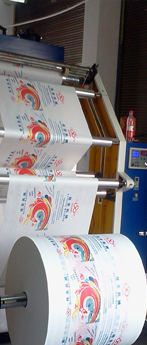Transfer Printing Application Sites
The only colorant class that is characterised as sublime is the dispersion colorant
agents. For this reason, it is the only colorant agent class suitable for transfer
printing. Requirement for working with fibres that could be dyed with these kinds
of colorants brings a restriction to the process. Such fibres are polyester, acetate,
triacetate, acrylic and polyamide (nylon) fibres. It is the most suitable for polyester
and polyester mixtures. Fibres used for transfer printing are as indicated below:
78% Polyester
16% Textured polyester
1% Polyamide
1% Polyacrylnitrile
1% acelate.
Natural fabric neither contains colorant nor is damaged by it; cotton content should
remain below 30% for efficiency purposes in case of transfer printing of polyester
cotton mixtures. Discovered in the late 1950s, the transfer printing has been developed
with advanced technology for the last 10 years. The transfer printing technology
has become widespread throughout the world since then. Transfer printing paper sellers,
printers and users engaged in the textile industry have witnessed the extraordinary
growth rate and progress. It is a known fact that the transfer printing constantly
grows in line with the textile printing. Transfer printing provides many advantages
compared to the conventional wet printing techniques.
